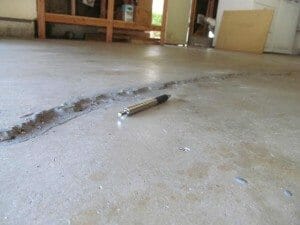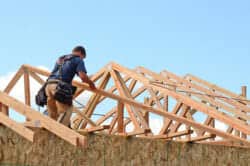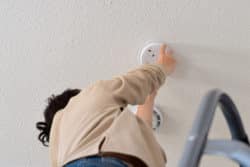Mold Causing Structural Damage Referred To As “Building Cancer”
Home » Structural »

Mold can affect the structural integrity of a home and some contractors refer to one of these troublesome molds, serpula lacrymans, as a “building cancer”. This term may scare some owners but in reality, it is manageable and needs to be addressed with common sense, not scare tactics.
Serpula lacrymans is a fungus that is basically found in wood and most people in the building industry refer to it as wood decay or “dry rot”, which can cause anything from minor to significant damage to a home’s wood structure. The extent of seriousness depends on a number of variables, such as the amount and extent of the damage that it has caused, the length of time that it has been present, and the location of the dry rot damage.
Dry Rot
Dry rot is basically wood that has a fungus decay which overtime deteriorates the wood and reduces its structural strength. Wood with dry rot generally should be replaced, whereas wood that has surface mold can often be cleaned or treated.
Funguses under some conditions may transport water to adjacent areas in order to continue their growth; similar to tree roots transporting water to the trunk and leaves of the tree. Dryness resistant spores of serpula lacrymans can remain viable for up to 20 years, so even if an area dries up, it may become active again if moisture becomes available.

Dry rot in wood-framed houses
Dry rot fungus can be found not only in wood, but it may grow through or in other materials like plaster, brick and block. In wood-framed homes dry rot may cause significant damage if not controlled or eliminated; unfortunately, many homeowners don’t discover it or address the issue until substantial damage has occurred.
Chances are you have not given much thought to whether your house has dry rot damage or not. You have probably had a doctor’s physical in the last few years and gone to the dentist to have your teeth checked; yet you have probably not checked your biggest investment for mold, dry rot or for structural damage. This is one of the reasons that dry rot goes unnoticed for long periods of time.
Looking for dry rot
Moisture issues are one of the reasons that structural problems develop in a home and when wood and moisture come in prolonged contact, then mold and dry rot often occurs. Dry rot may have a brownish or rust color to it, but can also be both blackish or even whitish in color depending on the material and the stage that the dry rot is in.
Wood with dry rot in advanced stages may easily puncture with a screwdriver and some may even crumble in your hand. It may be brittle in the advanced stages and have a “cubical cracking” look. See photo of advanced stages with “cubical cracking.
Common sources of moisture for dry rot
- Wood in contact with damp materials
- Leaks
- Drainage issues
1. Wood in contact with damp materials
Wood sill plates sitting on concrete foundations and slabs can draw moisture from the concrete, especially if untreated. Wood sill plates that have dry rot often get replaced with treated lumber which holds up better to dry rot. Wood ledgers, posts, or beams against concrete walls or floors may also draw moisture from the concrete and then decay; as concrete is a little like a sponge and water can easily move through it by capillary action.
2. Leaks
Roof leaks: Small roof leaks may go unnoticed for years. The roof’s wood sheeting (i.e plywood or OSB board – oriented strand board), gets wet from these leaks and slowly deteriorates and loses its strength. Other roof framing members, such as rafters, trusses, and beams may also get wet, and over time fungus and deterioration will set in. Roof leaks can result from the aging of a roof, damage to the roof, the underlayment deteriorating, or leaks in valley areas.
Plumbing leaks: Leaks from water lines, water heaters or sewer drain lines is another source of moisture. At times these go unnoticed for years; then when replacing a toilet, the flooring around the toilet is rotted and will need to be replaced or the same if a shower is replaced, the floor may need replacing because of wood rot. Leaks in walls, ceilings, and other places also may go undetected for years and once discovered, substantial amounts of structural damage may have occurred.
Bathroom fan vent terminated in the attic: If moisture-laden air from a bathroom fan is released into an attic or the vent piping is separated, then this may cause moisture issues in an attic, such as dripping water from condensation. This is especially common in the winter in cold climates. This moisture can result in mold and wood rot. Read about bathroom fan venting code requirements, mold and terminating the vent in the attic
3. Drainage
Poor drainage around the perimeter of a house may result in concrete foundations and slabs absorbing moisture and through capillary action, transporting the moisture to the wood framing members that are in physical contact with the concrete. Over time this leads to mold and dry rot fungi.
Homes with crawl spaces will often have moisture under them when there is poor drainage. Water may stand for days, weeks or even months and if in contact with wood, then fungi and deterioration often set in.
Bottom Line
Mold and funguses can be a health concern, but also some may be a structural concern. Over time, significant structural damage can occur to a home and the cost of repairing the damage can be very costly. More than likely homeowners insurance will not cover damage from dry rot, thus leaving the entire cost of repair to you, the owner.










Just rented a house and the owner repacked the water heater but it is leaning and he had it sitting on a mental pan and have it secured with metal straps. A green light flashes on the water heater. Should zi be concerned.